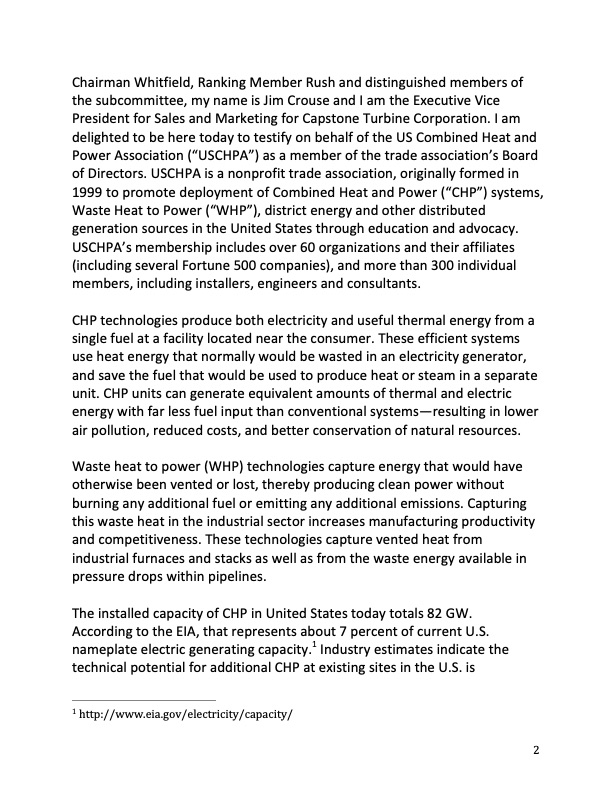
PDF Publication Title:
Text from PDF Page: 002
Chairman Whitfield, Ranking Member Rush and distinguished members of the subcommittee, my name is Jim Crouse and I am the Executive Vice President for Sales and Marketing for Capstone Turbine Corporation. I am delighted to be here today to testify on behalf of the US Combined Heat and Power Association (“USCHPA”) as a member of the trade association’s Board of Directors. USCHPA is a nonprofit trade association, originally formed in 1999 to promote deployment of Combined Heat and Power (“CHP”) systems, Waste Heat to Power (“WHP”), district energy and other distributed generation sources in the United States through education and advocacy. USCHPA’s membership includes over 60 organizations and their affiliates (including several Fortune 500 companies), and more than 300 individual members, including installers, engineers and consultants. CHP technologies produce both electricity and useful thermal energy from a single fuel at a facility located near the consumer. These efficient systems use heat energy that normally would be wasted in an electricity generator, and save the fuel that would be used to produce heat or steam in a separate unit. CHP units can generate equivalent amounts of thermal and electric energy with far less fuel input than conventional systems—resulting in lower air pollution, reduced costs, and better conservation of natural resources. Waste heat to power (WHP) technologies capture energy that would have otherwise been vented or lost, thereby producing clean power without burning any additional fuel or emitting any additional emissions. Capturing this waste heat in the industrial sector increases manufacturing productivity and competitiveness. These technologies capture vented heat from industrial furnaces and stacks as well as from the waste energy available in pressure drops within pipelines. The installed capacity of CHP in United States today totals 82 GW. According to the EIA, that represents about 7 percent of current U.S. nameplate electric generating capacity.1 Industry estimates indicate the technical potential for additional CHP at existing sites in the U.S. is 1 http://www.eia.gov/electricity/capacity/ 2PDF Image | For the House Energy and Commerce Energy and Power Subcommittee hearing:

PDF Search Title:
For the House Energy and Commerce Energy and Power Subcommittee hearing:Original File Name Searched:
HHRG-113-IF03-Wstate-CrouseJ-20130226-U1.pdfDIY PDF Search: Google It | Yahoo | Bing
Capstone Turbine and Microturbine: Capstone microturbines used and new surplus for sale listing More Info
Consulting and Strategy Services: Need help with Capstone Turbine, sizing systems, applications, or renewable energy strategy, we are here to assist More Info
Container Lumber Dry Kiln: Since 1991 developing and innovating dry kilns using standard shipping containers More Info
Supercritical CO2 Lumber Dry Kiln: Compact fast drying in 3 days or less for small amounts of wood and lumber drying More Info
BitCoin Mining: Bitcoin Mining and Cryptocurrency... More Info
Publications: Capstone Turbine publications for microturbine and distributed energy More Info
FileMaker Software for Renewable Energy Developing database software for the renewable energy industry More Info
CO2 Gas to Liquids On-Demand Production Cart Developing a supercritical CO2 to alcohol on-demand production system (via Nafion reverse fuel cell) More Info
Stranded Gas for low cost power Bitcoin Mining Using stranded gas for generators may provide breakthrough low power costs for cryptocurrency miners. More Info
| CONTACT TEL: 608-238-6001 Email: greg@globalmicroturbine.com | RSS | AMP |